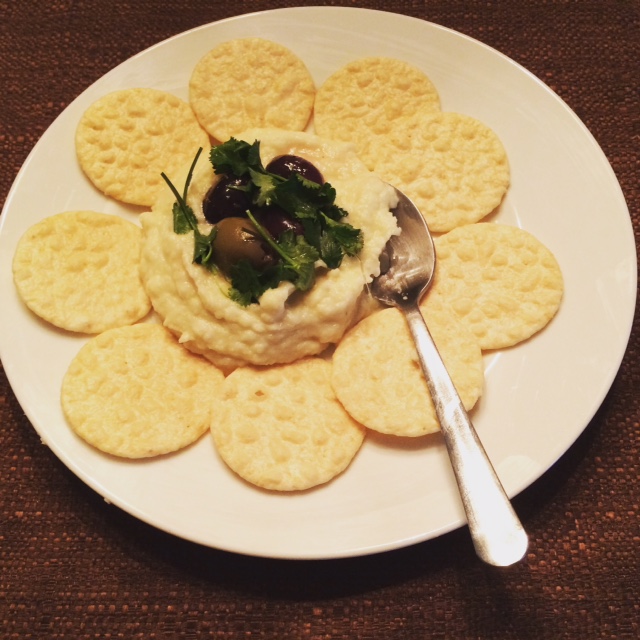
Miss hummus because of a legume and allium food allergy? Here’s a vegan and AIP compliant version that is tasty and super easy to make! Let’s eat!
Some years back, I reproduced a hummus recipe that was given to me by a person I once dated. He was a “foodie” – one of those men who took the time to know what was in his food, portion everything down to exactly how many crackers should be on plate with your spoonfuls of spread, and source his food from local farmer’s markets.
We both enjoyed hummus because it was that protein rich, easy-to-make food that is a staple of Mediterranean and Middle Eastern meals. When I was able to eat as a vegetarian, hummus and pita were weekly staples.
Well, his hummus recipe lasted longer than our dating life. Then I developed food allergies, and then Celiac Disease. On top of that, a recent diagnosis of an allium intolerance (low allergic response),and my long-standing intolerance to legumes such as soybean and chickpeas made me say good-bye formally to hummus, and I began snacking on brown rice crackers with a whole lot of ‘nuthin on them.
I know; boring boring BORING. Oh so horribly boring. I started fantasizing.
I fondly recall the amount of garlic this recipe called for: it easily had an entire compound bulb and two and half cans of drained chickpeas. My bellydance teacher at the time, a woman of Lebanese-Syrian background, complimented my hummus and asked for the recipe. I didn’t care that this hummus left me with breath that could kill someone standing on the other side of the room. It was delicious.
But if you have an allium allergy, how on earth do you get that pungent flavor that is at once strong, mellow, and sweet? And if you can’t have chickpeas or soybean, what options are left for a base?
Oh hungry Minions, my gut’s army of hungry hamsters calling out to be well fed with flavorful food has been working on an answer for you! There are limits to the magic*, but for a large contingent of you, you’ll find this allium-free and legume-free cauliflower hummus a tasty solution, and a fantastic pairing with vegetables, gluten-free pasta served cold (like a mac and cheese, but without the cheese), and gluten free brown rice crackers.
Allium Free Cauliflower Hummus
If this recipe sounds familiar, it’s because it shares a similar base to one you may have seen on Autoimmune-Paleo.com, one of my favorite sites for everything AIP and Paleo. Here’s a link to Mickey’s recipe, which calls for roasted cauliflower and has the alliums still in it. If you haven’t seen their website, please check it out.
Ingredients:
1 steamed or roasted head of cauliflower (you can steam it for a few minutes in an InstantPot if you’re under a time crunch; don’t forget to put a small amount of water at the bottom)
1/4 cup extra virgin olive oil
1 tsp Himalayan (or other high quality) pink salt
1 lemon, juiced (or if you prefer, 1 lime)
2 Tablespoons of water
2 Tablepoons of your favorite gluten-free flour (such as tapioca, or brown rice)
1-1/2 Tablespoons fennel seed
2 Tablespoons horseradish (there should only be two, maybe three ingredients in your horseradish, and it should be free of alliums)
Greek olives (for serving), parsley sprigs for presentation
Cooking instructions:
Place a cleaned head of cauliflower whole in a steamer or InstantPot, and steam until cauliflower is softened (in the InstantPot, that’s less than five minutes after heating up).
While the cauliflower is steaming, place all other ingredients in a blender (a Vitamix works great, but if yours is not so powerful, the cauliflower will be soft enough after steaming), and pulse blend until ingredients are combined.
Drain the steamed cauliflower thoroughly using a colander or slotted spoon, and add to the blender. On a low blend setting, puree the cauliflower into the liquid ingredients. Note that the fennel seeds will remain intact. Check the texture of the puree; if you prefer a more stiff texture, add another tablespoon of your favorite gluten-free flour.
The finished product will be warm from the blender. If you want to serve quickly, remove some of the hummus to a container and chill in the freezer for fifteen minutes; the remainder can be removed to a container in the refrigerator for future snacking. It will congeal slightly and should sit well on a cracker without dripping.
Place Greek olives, sliced in halves, and parsley sprigs on top of the hummus to be immediately served after chilling. Gluten free crackers and/or thinly sliced vegetables can be arranged around a small dish of the hummus or in a relish tray.
If you have no reaction to red pepper, you can shake a pinch of red pepper on top of the hummus before adding olives and parsley. If you want a fancy pants kick in heat, you can purchase allium-free red pepper flakes made from dried chiles, which are often easy to find in Mexican food stores or the Mexican food aisle in your local market. Check the manufacturer and ingredients if you are unsure if they are allium-free; the staff at Whole Foods got on their website to make sure the package I bought was allium free.
*Yes, there are limits to the magic. I am aware that those of you who may be following a strict FODMAPs diet will not be able to eat cauliflower, and you too are avoiding alliums because of their high fructose content. I feel your pain.
If I discover another base that is FODMAPs compliant, I will update this recipe in the future.
Also, on one sample of this recipe, I added a tablespoon of collagen powder for protein. This tasted fine if you ate it right away, but it made the remaining amount a bit gloppy in consistency. The solution is to store the hummus in the blender in the refrigerator, and pulse blend it on low each time you serve it. I must say, this is an easy way to sneak in some more protein if you are in need of it, and you likely won’t need the extra tablespoons of a gluten-free flour.




